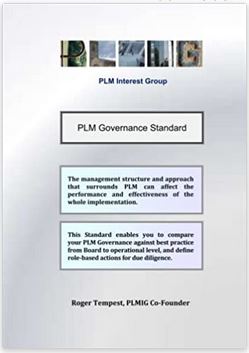|
PLM Interest Group |
|||||||||||||||||||||||
|
|
|
|
|||||||||||||||||||||
|
|
|
|||||||||||||||||||||
|
|
|
|
|||||||||||||||||||||
|
PLM Governance Standard
Purpose
PLM is a complex subject, and board level directors and VPs do not have the time to learn it in detail. The PLM Governance Standard sets out a procedure for the Board or leadership of a company to follow in order to include PLM within the scope of what is referred to in the USA as: ‘management oversight’ or, in its general sense: ‘due diligence’.
Scope and Application
The Standard covers all aspects of PLM Governance from the highest to the lowest levels of a company, across all organisational functions and all geographical locations. The highest level of a company is taken to be the Board, or group of directors, that has direct executive responsibility for the company. Higher-level boards, such as the Board of a holding company, are outside the Scope of this Standard, though the members of such a Board may find the Standard useful in whole or in part. The PLM Governance Standard applies to companies of all sizes from the largest corporations down to organisations of 300-500 people. At this lower level, a company will still have all of the problems and issues of PLM, and conventional management methods will apply. For companies of less than 300 people, a specific small-business approach is needed, and the PLM Handbook for SMEs is recommended instead. What the PLM Governance Standard Specifies
The PLM Governance Standard specifies a relatively simple set of requirements, placed upon four classes of person, or types of role, within the company:-
Companies with long experience of PLM will find that they already comply with many parts of the Standard, but its requirements, though expressed in simple terms, are suprisingly rigorous. A major benefit of applying the Standard is that it highlights adjustments and remedial actions that may currently be overlooked. The Standard does not rely on restrictive rules, and does not require extensive documentation of procedures. Care has been taken to keep it simple, lightweight and accurate. The Table of Contents gives a clear picture of the structure of the Standard. The Governance Driver
The management ‘power’ that makes PLM Governance work stems from the fact that the Board is shown exactly what information it must be provided with in order to fulfil its requirements to lead and direct the company. In the default, or ‘traditional’ PLM scenario, the PLM Manager and members of the PLM Team work at an organisational level several tiers below the top of the company, and face a continual ‘upward management’ problem in trying to convince their superiors of the value of what they are doing. Even where a senior director or VP heads up the PLM function, it is often regarded by other directors as a specialised area that does not concern them. If the PLM Governance Standard is followed, the top-down demand eliminates this upward management and disinterest. The PLM Team, Steering Group and other managers respond to the demand within the Governance framework, and are motivated to use their skills and best efforts to meet it. This feeds back to the Board, which provides new direction and new targets, and the process drives onward. Assessment
The PLM Governance Standard is not designed to be certified, with complex assessments and reassessments every few years. The Standard itself states: "There are no plans to introduce any kind of assessment or conformance evaluation for the PLM Governance Standard. Its value lies in improved business performance and increased competitive ability. [...] The details of the management framework that arises from applying the Standard may be specific to each company and may become part of its intellectual property." However, in large and complex organisations, an external assessment can be very useful. It reduces the internal workload and de-personalises the findings. Where PLM Governance is hampered by issues of culture, management communication or organisational structure, then a well-documented assessment from a recognised impartial source is a powerful way of gaining attention and agreement. In most cases, therefore, companies will apply the Standard for themselves, and the Board and the PLM Team will manage the results. If an external assessment is required, this can be provided by the PLMIG as part of Corporate Membership. How to Purchase the Standard
The PLM Governance Standard is provided with Q&A support to PLMIG Members, so you will receive a copy if you join with any class of Membership. Alternatively, you may buy hard copies from Amazon or electronic copies from the Store. For more information about PLM Governance, or the Standard itself, contact governance@plmig.com. © Copyright 2025 PLM Interest Group |
||||||||||||||||||||||
| <<< Return Home | |||||||||||||||||||||||
|
|
|
|
|||||||||||||||||||||





